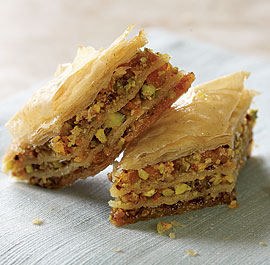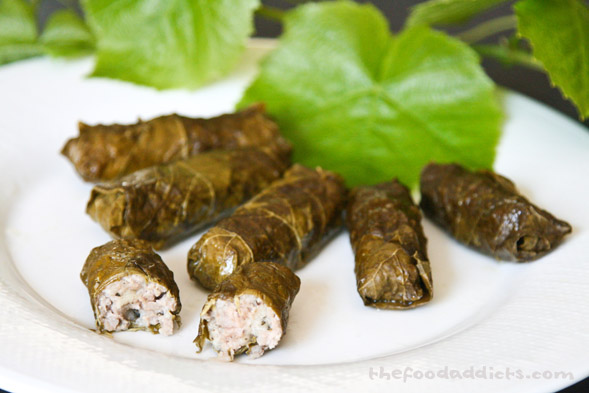The first one is Baklava. You most likely have seen this dessert, it is the one which has filo pastry and can be disgustingly sweet (in a good way). The pastry is layered between an array of crushed nuts and the pastry. And to make the pastry as sweet as it is it is drenched in syrup or honey.
Ingredients
375g (1 packet) filo pastry
180g butter, melted & cooled
2 tsp water
filling
150g walnut pieces
150g unsalted pistachios
55g (1/4 cup) caster sugar
1tsp ground cinnamon
honey syrup
375g jar honey
165g (3/4 cup) sugar
250mls (1 cup) water
1 lemon, rind finely grated and juiced
Method
Preheat oven to 180°C. To make the filling, spread the walnuts on a baking tray and lightly toast in the preheated oven for 5-8 minutes or until aromatic. Cool.
Combine walnuts, pistachios, sugar and cinnamon in the bowl of a food processor and process using the pulse button until they are finely chopped.
Remove the filo pastry from its packet and lie flat on the work bench. Cover with a dry tea towel and then a damp tea towel. (This will keep the filo from drying out while making the baklava.)
Brush a shallow 18 x 28cm cake tin with some of the butter. Take 1/3 of the sheets of filo. Brush the top sheet generously with butter and fold into thirds to make a rectangle the size of the tin. Place in the base of the buttered tin and brush surface with butter.
Continue layering with the left over 1/3 of pastry. Spread 1/2 of the nut filling over the filo to cover. Layer 1/2 of the remaining filo sheets as before. Spread left over nut filling over filo and top with the remaining layered buttered filo sheets. Lightly brush top with remaining butter.
Using a sharp knife, cut a diamond pattern into the top layer of filo and sprinkle with the water. Bake in preheated oven for 30 minutes. Cover with foil and cook for 45 minutes longer or until the filo layers are cooked through.
Meanwhile, to make the honey syrup, combine honey, sugar, water, lemon rind and juice in a saucepan and stir over high heat until sugar dissolves. Bring to the boil and maintain over medium heat for 10 minutes or until the syrup has thickened slightly.
Remove from heat and allow to cool. When cooked, remove baklava from the oven and immediately pour the cooled syrup evenly over the surface. Stand to cool completely. Cover with foil and store at room temperature in the tin for up to 2 weeks.
Cut into diamond shapes to serve with espresso coffee or as a dessert with whipped cream.

The next recipe which I will be sharing is another popular one, it is the one for Dolmades also known as stuffed vines. Dolmades can be eaten as a meze with ouzo or as a side dish. It can also be accompanied by Greek strained yoghurt as a tasty little snack on its own. As a tip and for a perfect dish the vine leaves used should be the first tender leaves of the spring.
Ingredients
50 vine leaves – approx. 10cm diameter
2 large onions grated
½ kg risotto rice
1 bunch chopped fennel
5 fresh mint leaves chopped
Juice from 2 medium lemons
2 cups extra virgin olive oil
Salt and pepper
Method
Wash the leaves in cold water. Place them in a large pan of boiling water for no longer than a minute – just to soften them. Remove the protruding edge of the central stem from each leaf. Place the leaves individually flat in a shallow oven dish and allow to cool.
In a shallow pan, gently fry the onions in 3 tablespoons of oil. Add the remaining ingredients and stir the mixture just the once before removing from the heat.
Place 1 level teaspoon of the mixture in the centre of each leaf and fold the leaf to make a small rectangular package.
Spread 5 vine leaves at the bottom of a shallow pan and place the dolmades next to each other in the pan with the folded side underneath. When you have completed one layer, make another layer of dolmades on top of them and then finally a third layer. Add the rest of the olive oil as well as 1 cup of water.
Place any remaining leaves across the top of the layers and then place a heavy plate on top to cover most of the surface. Put the lid on the pan, bring to the boil and simmer for 30 minutes or until there is only oil and no water. Remove the plate and add the lemon juice.
The dolmades can now be removed from the pan and served. The dish is also a perfect for vegetarians because it contains absolute no meat. So how about it, a classical Greek dish for Saturday night and finish it off with the perfect Greek dessert?
The dish is also a perfect for vegetarians because it contains absolute no meat. So how about it, a classical Greek dish for Saturday night and finish it off with the perfect Greek dessert?
That's all I have for now...
BYEE
No comments:
Post a Comment